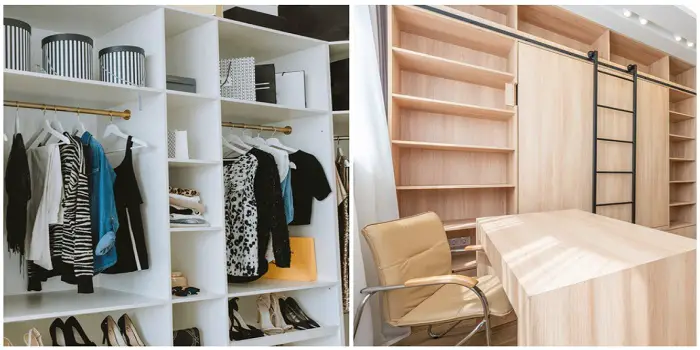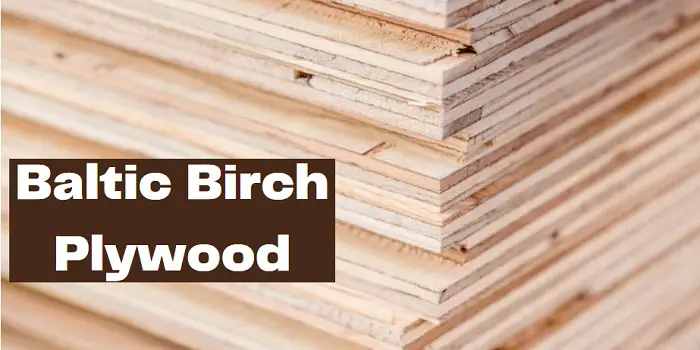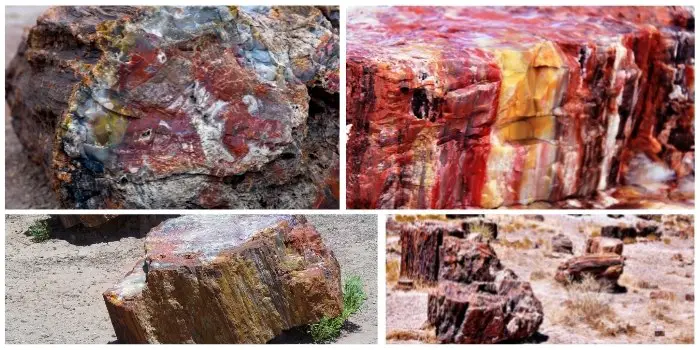
Petrified wood is a name for special kinds of fossilized remains of certain types of vegetation.
It happens when trees or similar woody plants transition completely to stone through what is known as permineralization.
During the process, all of the organic material is replaced by minerals such as quartz or some other silicate. At the same time, it retains the original structure of the stem tissue.
Unlike certain kinds of fossils that are usually compressions or impressions, petrified wood is an actual representation of the original organic matter in 3D.
How is it Formed?
Petrified wood forms over time when organic remains are replaced by minerals through a very slow petrification process that ultimately ends in quartz chalcedony mineralization.
This process takes place underground after wood becomes buried beneath volcanic ash or sediment. It begins its preservation process because of a lack of oxygen, which prevents decomposition.
There are certain conditions that have to be met before the organic material can be changed into petrified or fossil wood.
Generally speaking, the organic matter becomes buried in an oxygen-free environment that preserves the original structure of the plant as well as its general appearance.
Other conditions that must be met include having regular access to water rich in minerals, which must make contact with the tissues.
This will replace the organic plant matter with inorganic minerals to create petrified wood, wherein the material is turned to stone.
Exotic minerals can sometimes create the green and red hues that show up in rarer organisms.
Some of the minerals that are found in petrified wood include silicon dioxide, which is the base mineral for chalcedony, opal and quartz, calcite, iron oxides, manganese, cobalt, chromium, copper, and many others.
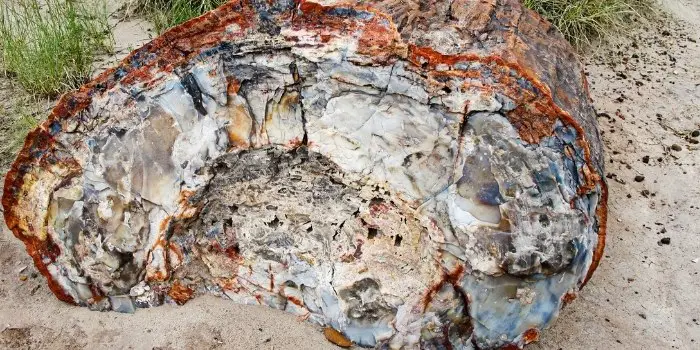
Why is Petrified Wood Heavy and Hard?
Petrified wood is approximately two or three times harder than average wood.
Depending on its type, the weight of petrified wood can range anywhere from 160-200 pounds per cubic foot.
The hardness of petrified wood rates between 7 and 8 on the Mohs Hardness Scale, where the diamonds are at 10.
The heaviness of the material is generally owed to its composition.
Beyond that, the heaviness and hardness of the material are also dictated by how densely packed the molecules are with the material in question.
With materials that are densely packed, meaning that the molecules are found close together, more molecules can be located in a sample as opposed to materials that aren’t as dense.
Regarding materials that make up living wood, the minerals in the petrified wood are denser than the molecules.
Therefore, the density of the molecules that determines whether or not wood floats is also what is responsible for the weightiness of petrified wood.
Is it harder than a piece of rock?
The answer to this question depends on several things. As mentioned, the heaviness of the material is dictated by the density of its composition.
Some rocks are lighter than others due to their composition, with pumice, for example, being quite lightweight. It floats and is not dense at all.
For this reason, petrified wood can be heavier than some kinds of rock, though it may be lighter than others. The sample sizes are also compared factors in the comparison.
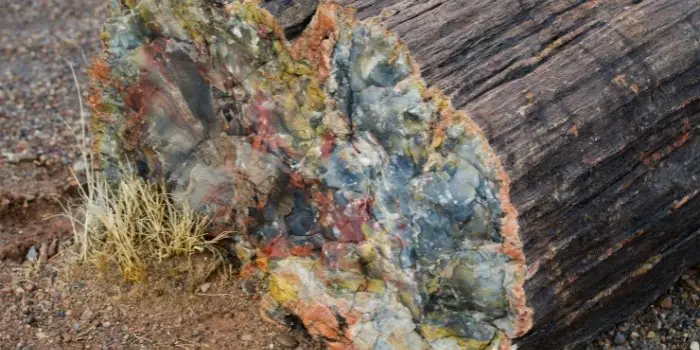
Different Types of Petrified Wood and Uses
Although there were some efforts in the past to create a category based on the plant species, there are no strict classifications of petrified wood available to date.
However, for the sake of understanding, petrified wood can be broadly classified into types based on its formation, colors, structure, and texture.
Petrified wood can be composed of compounds including Pyrite, Calcite, Opal, Chalcedony, Agate, Silica, and silicates such as quartz.
Based on the structure and texture, petrified wood can be classified as:
- Jet-like – that displays clear lines or wavy patterns
- Homogeneous Type – with uniform ring color
- Spotted Type – somewhat decorative
- Concentric Texture – comes with various color layers
Depending on the type and characteristics, petrified wood can be used in jewelry or for various decorative purposes such as making book ends, clock faces, table tops, and other ornamental objects like figurines.
Since petrified wood can be found in a variety of colors (such as brown, grey, red, blue, yellow, and green), many furniture manufacturers also use it to create unique pieces by incorporating petrified wood into the design.
Not only that, petrified wood is also known for its healing properties and spiritual benefits. People use these as healing stones to calm their scattered energies and to create balance in their lives.
Petrified wood is also used as a Feng Shui element to bring good luck, abundance, and prosperity.
Can Petrified Wood Get Wet, or Is It Waterproof?
The simple answer to this question is that, yes, petrified or fossilized wood can get wet. This type of wood isn’t completely waterproof.
Still, for a number of reasons, it isn’t recommended that you soak this wood in water for any length of time.
The organic material found in petrified wood has been replaced completely with certain minerals.
When the petrified wood is placed in water, the materials won’t absorb the water like wood made from organic material might.
Because of this, placing petrified wood in water for short periods if you need to clean it likely won’t harm the wood; however, extended periods of time are not recommended as this can harm the material.
Think of petrified wood as a stone because, technically, it is: if you put a stone in water, the molecules of water find their way into the cracks of the stone.
These water molecules can cause the slow widening of fissures over time, which can cause the stone to break or crack apart.
If you are hoping to make the wood into a sculpture, table, or another item of value, this can be detrimental to its durability.
Water Can Cause Rust or Discoloration
Petrified wood usually gets its hue from metals being present. Letting the wood sit in the water or otherwise get wet constantly can cause it to rust, which can turn the wood yellow and cannot be scrubbed clean.
If you let the wood get wet for long periods, the yellow can become an unsightly reddish-brown stain that is also difficult to remove.
When this occurs, sometimes you have to grind the rust off or cut it instead.
Also, remember that sometimes it can be difficult to know just what the petrified wood is made from. There could be toxic materials or metals in the stone that react poorly to the presence of water.
Some of the chemicals can leech into the water or even let off toxic gas into the air.
Keep in mind that just because a surface looks safe, it doesn’t mean there is nothing lurking beneath the surface that can interact with water.
Water Can Cause Damage to the Finish of Petrified Wood
The wood sitting in water can also harm the finishes added to petrified wood.
A lot of commercially sold minerals are coated with a thin layer of certain products that are made to give the stone a shinier, brighter look.
Such materials are sometimes oils, which you’ll have to reapply periodically. Other times, these commercial products have a tint to them to make the stone look better.
Regardless of the finish, when the finishes are stripped away, the stone will appear duller.
Water is also capable of diminishing the natural shine of material since the water molecules will sink into the surface of the stone, reducing light’s ability to refract the way it once did.
Soaking it in water can also facilitate other changes to the colors of the stone in a way that only grinding or cutting can remedy.
Collectors will often soak finished petrified wood in salt or mineral water, thinking this would strengthen and clean it, only to be disappointed with the finished result.
How Much is a Piece of Petrified Wood Worth – What Decides its Value?
The value of petrified wood varies widely, from less than $1 to more than $750, depending on the size, color, grade, and polishing.
Many collectors and jewelry makers value it according to its weight, ranging between $0.25 and $10.00 or more a pound.
The typical cost for a few-inch long rough limb is between $3.5 and $8, but polishing the limb may increase its value by up to $20.
But as it’s not as precious as many other gemstones, it’s not a suitable mineral material for investment purposes.
What determines the price?
Typically, the older the petrified wood is, the more value it holds. A few more determining factors that decide the overall worth of a petrified wood include:
- Size: the larger the piece, the pricier it is
- Color: specimens with vibrant and multiple colors are more valuable than those with a single color
- Clarity: pieces with fewer holes, flaws, and blemishes are worth more
- Patterns: unique patterns can make a petrified wood piece quite valuable
- Crystallization: there are pieces that are incorporated with expensive gemstones such as crystals or opals. These are usually the most expensive petrified wood and are worth much more than those which doesn’t have them.
If you happen to find any valuable petrified wood, you can either use it as a decorative piece or can sell it online at auction marketplaces such as eBay.
you can also find a local appraiser near you to value the piece and sell it at a much better price.
FAQs
Can petrified wood burn?
No, you can’t burn petrified wood. Despite the name, petrified wood is no longer “wood,” but it’s a stone.
Because it doesn’t burn, it’s also why some people use petrified wood to build their fireplaces.
If you happen to see any petrified wood that looks burned, it might be because the piece was burned before the petrification process has finished, like in a fire rage or some volcanic activity.
Why is petrified wood colorful?
The color of petrified wood can depend on the type of mineral that replaces the cell walls. Iron gives petrified wood a reddish hue, while manganese produces a black coloration.
Residuals of organic compounds sometimes also provide carbon which is generally seen as a gray and black shade on petrified wood.
Metals such as copper, chromium, and cobalt introduce the most brilliant hues when they enter the structure of petrified wood.
How long does it generally take for wood to petrify naturally?
Petrification can occur in 5,000 to 10,000 years in nature.
A tree may turn to stone in as little as 100 years, according to some sources. However, such specimens will not have the same hardness as older petrified wood samples.
These samples can easily be destroyed with little pressure and isn’t a good choice for creating decorative components.
What is special about the Petrified Forest – Can you take the rocks from there?
Petrified Forest National Park is a national park in the United States of America located in Navajo and Apache Counties, northeastern Arizona.
The Petrified Forest is recognized for its fossils, particularly fossil trees that lived during the Late Triassic Epoch about 225 million years ago.
While visitors are not allowed to take any of the petrified wood from the park, many still do it. It’s believed that the people who steal are cursed with bad luck.
Final Thoughts
Petrified wood can be found all around the world and has been used for many purposes, including construction and jewelry.
The reason why petrified wood is heavy and hard is that it was once a living tree. The cells in the wood were replaced by minerals over time, which makes the wood very dense.
Despite its weight and hardness, petrified wood is susceptible to cracking and breaking if not handled carefully. If you own a piece of this valuable wood, store it in a dry place where it will not be subjected to extremes in temperature or humidity levels.

Hi, I am Mark Garner a professional carpenter, woodworker, and DIY painter. I live in the small city of Peoria, Arizona as a semi-retired woodworker. I have started this blog with a simple motive to help you with my wood experience in this sector. If you like to know more about what I love doing and how it all got started, you can check more about me here.



